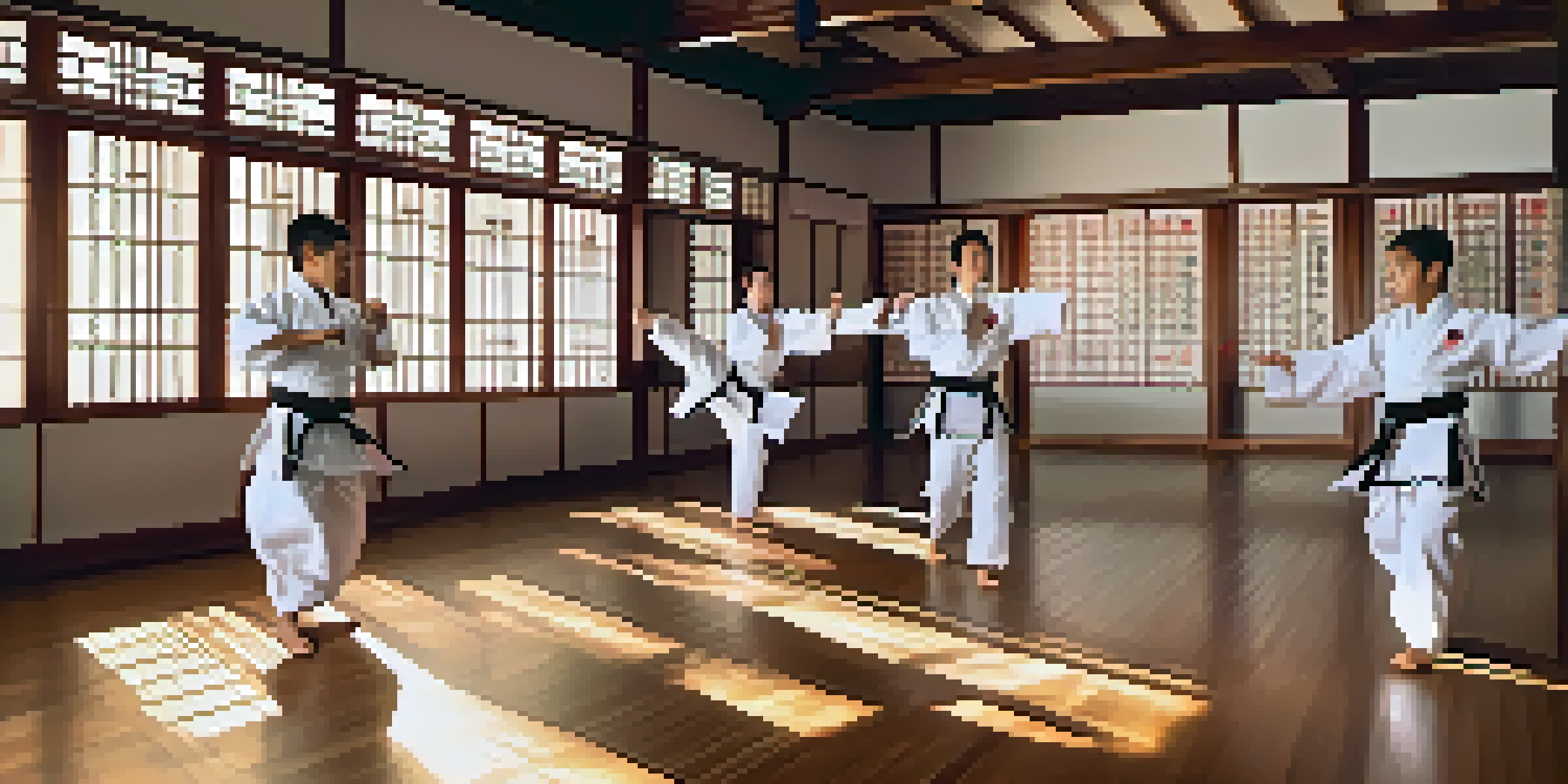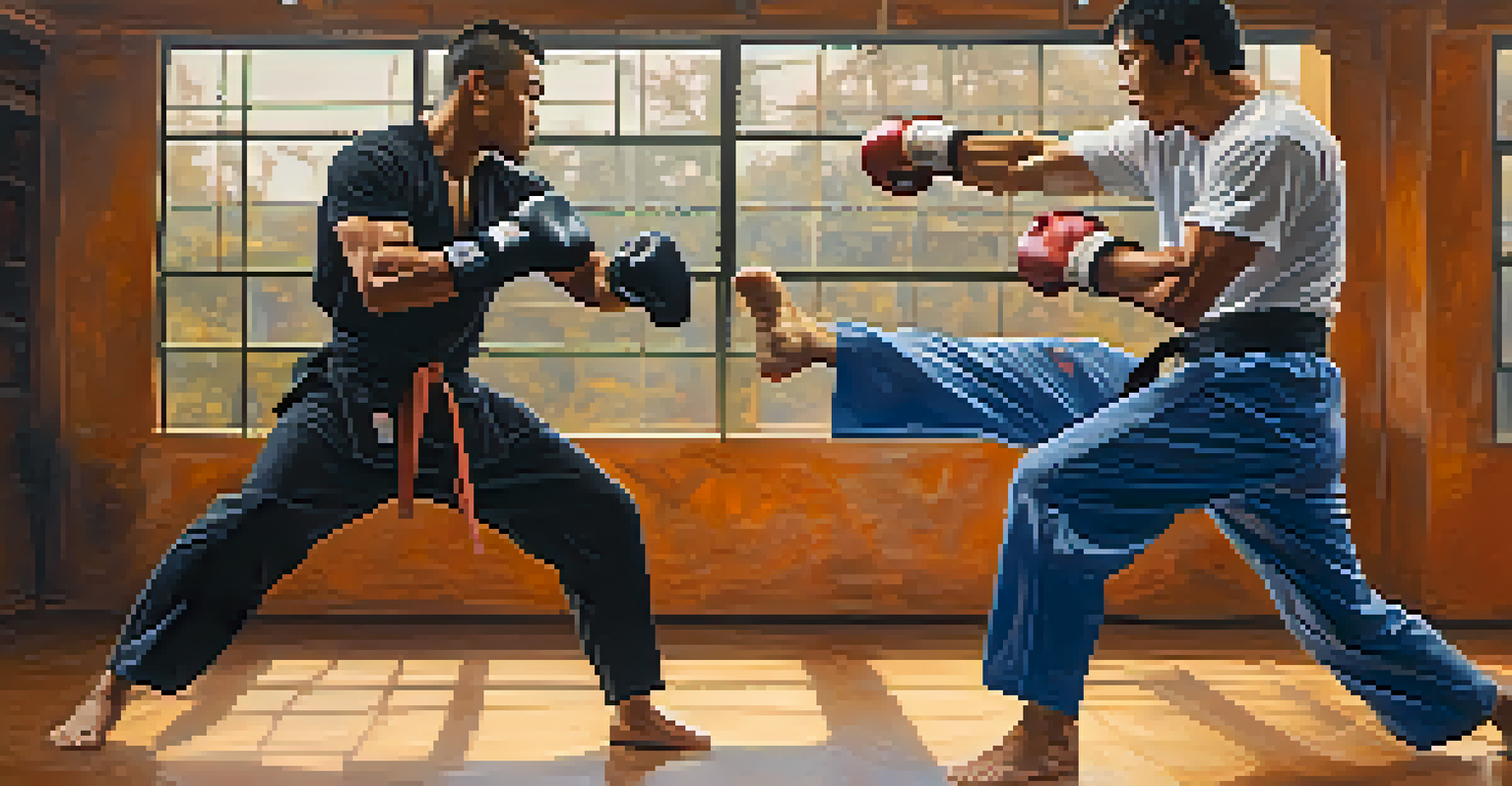The Connection Between Discipline in Martial Arts and Communication

Understanding Discipline in Martial Arts
Discipline in martial arts is more than just following rules; it's about cultivating a mindset that values focus and perseverance. Practitioners learn to respect their instructors, fellow students, and the traditions of the art. This mindset forms the foundation of their training, enabling them to push through challenges and setbacks.
Discipline is the bridge between goals and accomplishment.
In martial arts, discipline manifests through regular practice, attention to detail, and the consistent effort to improve. This dedication not only hones physical skills like strikes and stances but also instills a sense of responsibility and commitment in practitioners. The journey is as important as the destination, and discipline is the guiding force.
Moreover, this discipline translates into everyday life, teaching students to approach tasks methodically and with intent. Whether it's mastering a technique or preparing for a competition, the habits formed through martial arts training set the stage for success beyond the dojo.
The Role of Communication in Martial Arts
Communication in martial arts is crucial, whether it's verbal cues from instructors or non-verbal signals during sparring. Practitioners must learn to express themselves clearly, both in terms of asking questions and giving feedback. This is particularly important in sparring, where understanding your partner's movements can make all the difference.

Additionally, martial arts emphasizes the importance of body language, which can convey confidence, intent, and respect. When students learn to read these cues, they become more perceptive to the dynamics of a situation, enhancing their interactions both inside and outside the dojo. This heightened awareness can lead to more effective communication skills overall.
Discipline Shapes Mindset and Skills
In martial arts, discipline fosters a focused mindset that enhances both physical skills and personal responsibility.
Through practice, martial artists develop a unique language that combines verbal and non-verbal elements. This fluency allows them to connect with others more deeply, fostering camaraderie and teamwork as they work towards common goals.
How Discipline Enhances Communication Skills
The discipline cultivated through martial arts training enhances communication skills by fostering patience and active listening. In a typical class, students must pay attention to detailed instructions and practice them diligently, which sharpens their ability to absorb and respond to information. This skill is invaluable in everyday conversations and professional settings.
The greatest weapon against stress is our ability to choose one thought over another.
As martial artists learn to control their emotions and reactions, they also become better at managing interpersonal communications. The ability to remain calm under pressure translates to more thoughtful, composed responses in challenging discussions, whether at work or home. This improved emotional regulation is a direct benefit of the discipline learned in the dojo.
Furthermore, the practice of receiving and giving constructive feedback during training sessions builds a culture of open communication. Students learn to express their thoughts respectfully and considerately, which strengthens their overall ability to convey ideas clearly and effectively.
Building Confidence Through Discipline
Discipline in martial arts is a powerful confidence builder. As students master techniques and achieve new ranks, they gain a sense of accomplishment that spills over into other areas of their lives. This boost in self-esteem often encourages them to engage more assertively in conversations and social situations.
In addition, the structured environment of martial arts classes allows students to practice public speaking and assertiveness. Sharing experiences or techniques with peers fosters a sense of community and encourages individuals to articulate their thoughts and feelings with clarity. This practice is essential for developing communication skills.
Communication Skills Through Training
Practicing martial arts improves communication by teaching active listening, non-verbal cues, and effective feedback.
Confidence gained from martial arts also empowers practitioners to navigate difficult conversations or conflicts more effectively. They learn to approach these situations with a calm demeanor and a clear mind, allowing them to express themselves more openly and honestly.
Listening Skills Developed Through Training
Listening is a critical component of both martial arts and effective communication. In the dojo, students must listen intently to their instructors to grasp the nuances of techniques and strategies. This practice of focused listening translates to everyday life, where active listening can enhance personal and professional relationships.
Through sparring and partner drills, martial artists also learn to pay attention to their opponent's movements and intentions. This heightened awareness fosters a deeper understanding of non-verbal cues, making them more adept at interpreting others' feelings and motivations. Such skills can be particularly useful in negotiations or conflict resolution.
Ultimately, the listening skills honed in martial arts create a foundation for empathetic communication. Practitioners become more attuned to others, which helps them respond thoughtfully in conversations, leading to more meaningful connections.
The Importance of Non-Verbal Communication
Non-verbal communication plays a significant role in martial arts, where body language often speaks louder than words. Practitioners learn to observe and interpret their opponents' movements, which enhances their ability to read situations in everyday life. This skill is essential for effective communication, as non-verbal cues often convey emotions and intentions.
By focusing on posture, gestures, and facial expressions during training, martial artists become more mindful of their own non-verbal signals. This awareness can lead to improved self-presentation and the ability to convey confidence and authority in various situations. Understanding how to project the right message without saying a word can be a game-changer in both personal and professional interactions.
Confidence Boost from Martial Arts
The discipline of martial arts builds confidence, empowering practitioners to engage more assertively in conversations.
Furthermore, the practice of maintaining eye contact during sparring or instruction builds trust and rapport between practitioners. This emphasis on eye contact translates to more engaging conversations, as individuals who maintain eye contact are often perceived as more trustworthy and approachable.
Applying Martial Arts Principles to Everyday Communication
The principles of discipline, respect, and focus learned in martial arts can be effectively applied to everyday communication. For instance, approaching conversations with the same respect and attention as one would show a martial arts instructor fosters more meaningful interactions. This mindset encourages individuals to value the opinions of others, leading to more productive discussions.
Additionally, the conflict resolution skills developed in martial arts can be invaluable in personal and professional settings. Practitioners learn to approach conflicts with calmness and clarity, seeking solutions rather than escalating tensions. This ability to navigate challenging conversations is a direct result of the discipline ingrained in martial arts training.

Ultimately, the connection between martial arts discipline and communication goes beyond the dojo. By integrating these principles into daily life, individuals can enhance their relationships, foster collaboration, and communicate more effectively with those around them.